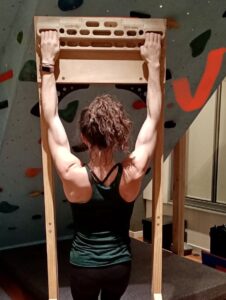Climbing’s growing popularity and the closure of gyms has made hangboarding a popular and new endeavour for many climbers. The wooden board that might seem like a strange torture device provides an amazing opportunity for climbers to build strength and resilience in an area that is most often their weakest link, the fingers.
This Three-Part Hangboarding Series will look at why hangboarding is a great tool, some tips at getting started, and common injuries that can occur. Keep checking this space for more blogs and news from our Bend + Mend climbing Physio, Meredith.
If you are new to climbing (training for less than 18 months) it is generally advised to focus on route climbing as the primary method to build finger strength. Initiating a hangboard protocol without base strength in tendons and ligaments can lead to finger injuries that will sideline your training. However, tools such as using a pulley system or foot support to adjust body weight, can help beginners.
For advanced climbers looking to push their competitive edge, hangboarding is a crucial tool for the next grade. Research that looked at subjects who underwent a hangboard program as well as regular climbing training were compared to controls who only did climbing training. The study group demonstrated increased performance scores at the end of the seven-week trial.
A hangboard is a wooden or plastic structure with 20+ artificial holes which climbers place their fingers to hang off.
When hangboarding, we load multiple structures in the body, most specifically the finger flexors (flexor digitorum profundus & superficialis ) and the connective tissue that wraps around the finger flexor tendons to form a sheath with five thickened areas called annular pulleys; A1, A2, A3, A4, A5. These pulleys keep the tendon close to the bone when bending the fingers.
As we load the fingers on the hangboard, force is transmitted through these structures. By progressively increasing load, the structures adapt and get stronger. However, too much load too soon can lead to pain and injury. More on injury in part three.
There are three main types of adaptation. Structural adaption is the increase in muscle cross sectional area (think the bigger arm muscles with weightlifting) and thickening of the connective tissue properties. Basically, the muscles grow, and the pulleys get thicker and thus can take more load. The second is neuromuscular adaptation which influences how the brain and the body connect. This adaptation allows the brain to recruit muscles more efficiently. By practicing hangboarding the nervous system becomes more adapt at controlling the action of the muscles involved with the loading movement through fingers. Third is metabolic adaptation which influences the body’s ability to utilise stored energy more effectively.
These adaptations can be brought on by different training methods to suit your climbing goals. Adding weight to the body or using smaller holds will increase the intensity of your training. You can also adjust the duration of each hang or how many sets you do to influence your endurance. Regardless of your goals it is important to start with a strong base, adequate rest and good technique for best results. Part two looks at how to warm up and hangboard with good technique.
See Part two – Injury Prevention and Part Three – Finger Injury Management of our hangboarding series. If you need some Physio advice, or have a climbing injury, book in to see Meredith at Bend + Mend who loves treating climbing injuries and is an avid climber herself!
Resources
https://www.tensionclimbing.com/hangboarding-a-way/
Goddard, D., & Neumann, U. (1993). Performance rock climbing Mechanicsburg, PA: Stackpole.
KINGSLEY, A. K. The effects of hangboard exercise on climbing performance and grip strength in college see female indoor rock climbers. MS in Adult Fitness/Cardiac Rehabilitation, December 1997,49pp. (J. Steffen)
Horst, E. (1996). No excuses: Fingerboard workouts that don’t cramp your style. Climbing. 159, 150- 152.
Russum, W. (1 989). Phvsiological determinants of rock climbing abilitv, Unpublished master’s thesis, San Jose State University, San Jose, CA






